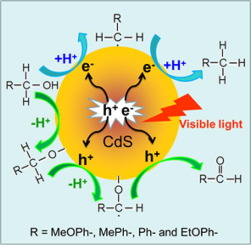Journal of Catalysis ( IF 6.5 ) Pub Date : 2017-12-01 , DOI: 10.1016/j.jcat.2017.11.015 Sugang Meng , Xiaofeng Ning , Susheng Chang , Xianliang Fu , Xiangju Ye , Shifu Chen

|
Photocatalytic selective organic transformation using photoexcited holes and electrons has attracted worldwide interest. Although extensive studies have made significant progress in dehydrogenation of alcohols, hydrogenolysis of alcohols using photoexcited electrons directly constitutes a challenge. Here, photocatalytic selective dehydrogenation and hydrogenolysis of aromatic alcohols into corresponding alkanes/ethers and aldehydes has been achieved by direct use of photoexcited electrons and holes over CdS under visible light irradiation. Compared with other popular visible-light-driven photocatalysts, Sb2S3, Bi2O3, N-doped TiO2, Zn3In2S6, g-C3N4, and Ce2S3, the sum of the yields of alkanes and aldehydes over the as-prepared CdS could reach up to 94% after reaction for 4 h. The high photoactivity and stability of CdS toward dehydrogenation and hydrogenolysis of aromatic alcohols can be ascribed to its appropriate band potentials and effective charge separation–transportation. The optimum positions are that the valence band position should be located between oxidation potentials of alcohol/aldehyde and aldehyde/oxidized aldehyde, and the conduction band position should be more slightly negative than reduction potential of alkane/alcohol. During this reaction, the dehydrogenation reaction consumes two holes and produces two protons; the hydrogenolysis process depletes two electrons and two protons. Therefore, a cooperative, cyclical, and efficient reaction system was established.
中文翻译:

通过可见光驱动的非均相光催化作用,在一个反应系统中同时进行芳香醇的脱氢和氢解反应
使用光激发空穴和电子进行光催化选择性有机转化已引起全世界的关注。尽管广泛的研究在醇的脱氢方面取得了重大进展,但是使用光激发电子对醇进行氢解直接构成了挑战。在此,通过在可见光照射下直接在CdS上使用光激发电子和空穴,已经实现了芳香醇的光催化选择性脱氢和氢解成相应的烷烃/醚和醛。与其他流行的可见光驱动的光催化剂相比,Sb 2 S 3,Bi 2 O 3,N掺杂的TiO 2,Zn 3 In 2 S 6,gC 3 N 4和Ce 2 S 3反应4小时后,在制备的CdS上,烷烃和醛的收率之和最高可达到94%。CdS对芳族醇的脱氢和氢解反应具有很高的光活性和稳定性,这归因于其合适的能带势和有效的电荷分离-传输。最佳位置是价带位置应位于醇/醛和醛/氧化醛的氧化电势之间,并且导带位置应比烷烃/醇的还原电势略为负。在该反应过程中,脱氢反应消耗两个孔并产生两个质子。氢解过程消耗了两个电子和两个质子。因此,建立了一种协作,循环,高效的反应体系。











































 京公网安备 11010802027423号
京公网安备 11010802027423号